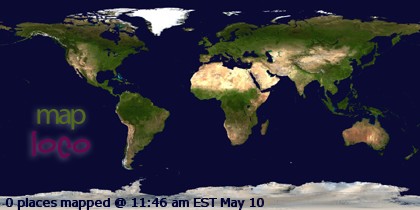The Loving Embrace of Summer...
Andrea and I are back in Tucson after three weeks of travel. Naturally, today is tile installation day, so we have a bunch of nice folks here making loud noises hammering tile off the wall so they can install new. Very sad - we wanted subway tile in our kitchen, but when the original installers installed it, they used traditional Tucson grout lines - about a quarter inch thick. Needless to say, this did not look good. Update: the banging has mostly stopped. Yay!
Anyway, Tucson is experiencing a major heat wave, but it's a desert heat wave, which has some unusual characteristics. I drove to Yoga class this morning with the windows rolled down, enjoying the cool breeze. This despite the fact that the temperature yesterday supposedly was around 103 degrees at sunset. When my yoga class (turns out it was just a practice session - Lisaji is still in New York) let out, the temperature was already 89 degrees, and although that is still fairly cool when the air is really dry, I switched to air conditioning.
I wanted to wander away from the serious topic of the previous post, although I am sure I will bore you with it again, and just describe an experience I had when I was in Oklahoma. A little context: my mother's family purchased a section (160 acres) of land near Claremore way back when (I'm not sure, but I think sometime in the early decades of the twentieth century). Claremore is in the part of Oklahoma that used to be referred to as "Green Country", although climate change has now rendered much of Oklahoma sufficiently green that I'm not sure this distinction is still made.
When I was a kid, the farm was a real farm - I remember harvesting potatoes with my great grandfather - Grampa Jean - when he was 80. His name was actually Eugene Dickerson, but I didn't know that when he was alive - he died when I was nine - so he'll always be Grampa Jean to me. They also ran cattle, although I didn't see much of that. I do remember working in the hay barn when I was a kid, and I think my first experience controlling a truck was when I was about 13, and I was tasked with driving the hay truck through the field as the larger and more muscular members of the family tossed bales up onto the truck or stacked them.
The southernmost 80 acres of the farm were where the cattle were run, and also where the swimming hole was. I remember walking out to the swimming hole when I was a kid, with Missy and JJ and Signe and Sandra. We'd go barefoot, which was really stupid, because the walk out was all broken rock, crab grass, and those nasty thistles that they have out there that look like little crabs, and bite into your feet with a barb that you can't get out without drawing blood. But we'd walk out and dive off the high spot into the deep part of the pond, and swim around for hours.
When Andrea and I were in Oklahoma two weeks ago, Sandra took us for a tour of the back 80 acres. It's so different. They haven't run cattle on it in years, and even the last time they did run cattle, it wasn't a very big herd. The grass is a thick blanket, entirely covering the areas of broken stone, which themselves are now covered in topsoil. Beavers roam the land, and the dams they've built I think are responsible for a lot of the change. The spot where we used to dive, which was nothing but broken rock, is now grassy and green, and the only rock you can see the rock is along the edge of the lake, where the land drops off straight down into the water, and it can't hold soil.
Wildflowers are growing everywhere. There are so many blackberry brambles that Sandra has certain favorites that she picks, and she leaves the others alone. She has a freezer full of blackberries that she picked last summer. The blackberries were in bloom when we went back, so they looked like great bonnets of lace strewn about the meadows. We saw a little baby snake, birds everywhere, maybe even a rabbit or two - I can't remember.
Land everywhere doesn't recover like this - Claremore really is green country - but it's hopeful to see something like this: to see that the damage done by overgrazing really can be recovered, and in a remarkably small period of time. The land out in Arizona where we're building our retreat center is similarly damaged by cattle grazing. I think it will take longer to recover than the land in Claremore did, because we get so much less rainfall, but it would be nice to see it covered one day in tall grass and oak groves. Seeing the back 80 in Claremore gave me hope.
Anyway, Tucson is experiencing a major heat wave, but it's a desert heat wave, which has some unusual characteristics. I drove to Yoga class this morning with the windows rolled down, enjoying the cool breeze. This despite the fact that the temperature yesterday supposedly was around 103 degrees at sunset. When my yoga class (turns out it was just a practice session - Lisaji is still in New York) let out, the temperature was already 89 degrees, and although that is still fairly cool when the air is really dry, I switched to air conditioning.
I wanted to wander away from the serious topic of the previous post, although I am sure I will bore you with it again, and just describe an experience I had when I was in Oklahoma. A little context: my mother's family purchased a section (160 acres) of land near Claremore way back when (I'm not sure, but I think sometime in the early decades of the twentieth century). Claremore is in the part of Oklahoma that used to be referred to as "Green Country", although climate change has now rendered much of Oklahoma sufficiently green that I'm not sure this distinction is still made.
When I was a kid, the farm was a real farm - I remember harvesting potatoes with my great grandfather - Grampa Jean - when he was 80. His name was actually Eugene Dickerson, but I didn't know that when he was alive - he died when I was nine - so he'll always be Grampa Jean to me. They also ran cattle, although I didn't see much of that. I do remember working in the hay barn when I was a kid, and I think my first experience controlling a truck was when I was about 13, and I was tasked with driving the hay truck through the field as the larger and more muscular members of the family tossed bales up onto the truck or stacked them.
The southernmost 80 acres of the farm were where the cattle were run, and also where the swimming hole was. I remember walking out to the swimming hole when I was a kid, with Missy and JJ and Signe and Sandra. We'd go barefoot, which was really stupid, because the walk out was all broken rock, crab grass, and those nasty thistles that they have out there that look like little crabs, and bite into your feet with a barb that you can't get out without drawing blood. But we'd walk out and dive off the high spot into the deep part of the pond, and swim around for hours.
When Andrea and I were in Oklahoma two weeks ago, Sandra took us for a tour of the back 80 acres. It's so different. They haven't run cattle on it in years, and even the last time they did run cattle, it wasn't a very big herd. The grass is a thick blanket, entirely covering the areas of broken stone, which themselves are now covered in topsoil. Beavers roam the land, and the dams they've built I think are responsible for a lot of the change. The spot where we used to dive, which was nothing but broken rock, is now grassy and green, and the only rock you can see the rock is along the edge of the lake, where the land drops off straight down into the water, and it can't hold soil.
Wildflowers are growing everywhere. There are so many blackberry brambles that Sandra has certain favorites that she picks, and she leaves the others alone. She has a freezer full of blackberries that she picked last summer. The blackberries were in bloom when we went back, so they looked like great bonnets of lace strewn about the meadows. We saw a little baby snake, birds everywhere, maybe even a rabbit or two - I can't remember.
Land everywhere doesn't recover like this - Claremore really is green country - but it's hopeful to see something like this: to see that the damage done by overgrazing really can be recovered, and in a remarkably small period of time. The land out in Arizona where we're building our retreat center is similarly damaged by cattle grazing. I think it will take longer to recover than the land in Claremore did, because we get so much less rainfall, but it would be nice to see it covered one day in tall grass and oak groves. Seeing the back 80 in Claremore gave me hope.



2 Comments:
You can tell my son was not raised Western: A section (a square mile) is 660 acres. Our farm (most of it purchased from the heirs of a Cherokee girl who had received it as her allotment at OK statehood in 1907) was 220 acres, a third of a section.
Ted,
Your meditations are wonderful!--insightful, enlivened by anecdotes and vignettes, and beautifully written. Don't stop.
Post a Comment
<< Home